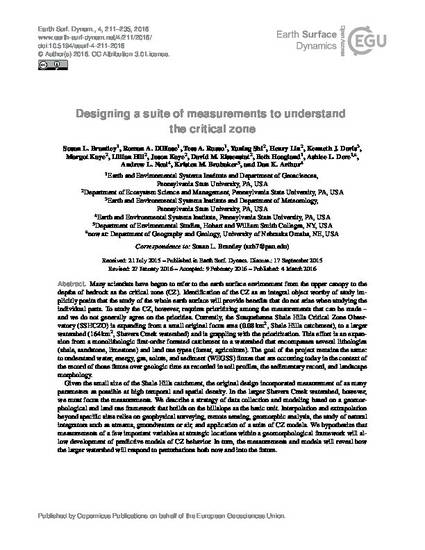
- Geology and
- Soil Science
Many scientists have begun to refer to the earth surface environment from the upper canopy to the depths of bedrock as the critical zone (CZ). Identification of the CZ as an integral object worthy of study implicitly posits that the study of the whole earth surface will provide benefits that do not arise when studying the individual parts. To study the CZ, however, requires prioritizing among the measurements that can be made – and we do not generally agree on the priorities. Currently, the Susquehanna Shale Hills Critical Zone Observatory (SSHCZO) is expanding from a small original focus area (0.08 km2 , Shale Hills catchment), to a larger watershed (164 km2 , Shavers Creek watershed) and is grappling with the prioritization. This effort is an expansion from a monolithologic first-order forested catchment to a watershed that encompasses several lithologies (shale, sandstone, limestone) and land use types (forest, agriculture). The goal of the project remains the same: to understand water, energy, gas, solute, and sediment (WEGSS) fluxes that are occurring today in the context of the record of those fluxes over geologic time as recorded in soil profiles, the sedimentary record, and landscape morphology.
Given the small size of the Shale Hills catchment, the original design incorporated measurement of as many parameters as possible at high temporal and spatial density. In the larger Shavers Creek watershed, however, we must focus the measurements. We describe a strategy of data collection and modeling based on a geomorphological and land use framework that builds on the hillslope as the basic unit. Interpolation and extrapolation beyond specific sites relies on geophysical surveying, remote sensing, geomorphic analysis, the study of natural integrators such as streams, groundwaters or air, and application of a suite of CZ models. We hypothesize that measurements of a few important variables at strategic locations within a geomorphological framework will allow development of predictive models of CZ behavior. In turn, the measurements and models will reveal how the larger watershed will respond to perturbations both now and into the future.
Available at: http://works.bepress.com/ashlee-dere/8/

© Author(s) 2016. CC Attribution 3.0 License